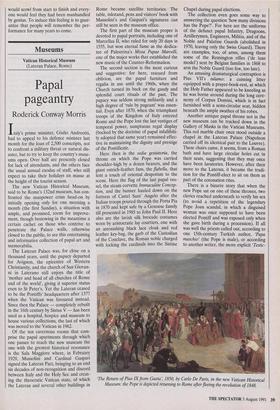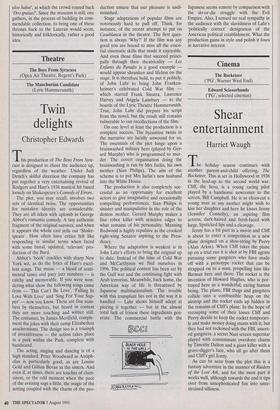Museums
Papal pageantry
Roderick Conway Morris
Italy's prime minister, Giulio Andreotti, had to appeal to his defence minister last month for the loan of 2,500 conscripts, not to confront a military threat or natural dis- aster, but to try to keep the country's muse- ums open. Over half are presently closed for lack of attendants, and the others face the usual annual exodus of staff, who still expect to take their holidays en masse at the height of the tourist season.
The new Vatican Historical Museum, said to be Rome's 132nd museum, has con- fronted the manpower crisis head-on by initially opening only for one morning a month (the first Sunday), a situation with ample, and promised, room for improve- ment; though bestowing in the meantime a certain cachet on those who contrive to penetrate the Palace walls, otherwise closed to the public, to see this entertaining and informative collection of papal art and memorabilia.
The Lateran Palace was, for close on a thousand years, until the papacy departed for Avignon, the epicentre of Western Christianity, and the church of San Giovan- ni in Laterano still enjoys the title of `mother and head of all churches of Rome and of the world', giving it superior status even to St Peter's. Yet the Lateran ceased to be the Pontiffs' headquarters after 1377 when the Vatican was favoured instead. Since then the Palace — completely rebuilt in the 16th century by Sixtus V — has been used as a hospital, hospice and museum to house various collections, the last of which was moved to the Vatican in 1962.
Of the ten cavernous rooms that com- prise the papal apartments through which one passes to reach the new museum the one with the greatest historical resonance is the Sala Maggiore where, in February 1929, Mussolini and Cardinal Gaspari signed the Lateran Pact, bringing to an end six decades of non-recognition and discord between Italy and the Holy See and creat- ing the theocratic Vatican state, of which the Lateran and several other buildings in Rome became satellite territories. The table, inkstand, pens and visitors' book with Mussolini's and Gaspari's signatures can still be seen in the museum office.
The first part of the museum proper is devoted to papal portraits, including one of Marcellus II, who ruled for only 20 days in 1555, but won eternal fame as the dedica- tee of Palestrina's Missa Papae Marcelli, one of the major works that established the new music of the Counter-Reformation.
The second section is the most curious and suggestive: for here, rescued from oblivion, are the papal furniture and regalia in use until the 1960s, when the Church turned its back on the gaudy and splendid court rituals of the past. The papacy was seldom strong militarily and a high degree of 'rule by pageant' was essen- tial. Even after 1870, when the triumphant troops of the Kingdom of Italy entered Rome and the Pope lost the last vestiges of temporal power, sumptuous regal display (backed by the doctrine of papal infallibili- ty adopted that same year) remained effec- tive in maintaining the dignity and prestige of the Pontificate.
Here then is the sedia gestiatoria, the throne on which the Pope was carried shoulder-high by a dozen bearers, and the giant ostrich-feather fans, the flabella, that lent a touch of oriental despotism to the scene. Here the flag of the last papal ves- sel, the steam corvette Immaculate Concep- tion, and the banner hauled down on the fortress of Castel Sant' Angelo after the Italian troops poured through the Porta Pia in 1870 and kept safe by a Genoese family till presented in 1985 to John Paul II. Here also are the lavish silk brocade costumes worn by aristocratic lay courtiers, one with an astonishing black lace cloak and red leather key-bag, the garb of the Custodian of the Conclave, the Roman noble charged with locking the cardinals into the Sistine Chapel during papal elections.
The collection even goes some way to answering the question 'how many divisions has the Pope?'. For here are the uniforms of the defunct papal Infantry, Dragoons, Artillerymen, Engineers, Militia, and of the Noble and Palatine Guards (abolished in 1970, leaving only the Swiss Guard). There are examples, too, of arms, among them some of the Remington rifles (`de luxe model') sent by Belgian families in 1868 to arm the Noble Guard (too few, too late). An amusing dramaturgical contraption is Pius VII's talamo: a cunning litter equipped with a prayer-book-rest, at which the Holy Father appeared to be kneeling as he was borne around during the long cere- mony of Corpus Domini, which is in fact furnished with a semi-circular seat, hidden beneath the ample swathes of his robes.
Another antique papal throne not in the new museum can be tracked down in the Gallery of Masks in the Vatican Museums. This red marble chair once stood outside a chapel in the Lateran Palace (Napoleon carried off its identical pair to the Louvre). These chairs came, it seems, from a Roman bath and have large circular holes cut in their seats, suggesting that they may once have been lavatories. However, after their move to the Lateran, it became the tradi- tion for the Pontiff-elect to sit on them as part of the coronation rites.
There is a bizarre story that when the new Pope sat on one of these thrones, two clerics reached underneath to verify his sex (to avoid a repetition of the legendary Pope Joan scandal, in which a disguised woman was once supposed to have been elected Pontiff and was exposed only when she gave birth during a procession). If all was well the priests called out, according to one 15th-century Turkish author, 'Papa maschio' (the Pope is male), or according to another writer, the more explicit `Testic- The Return of Pius IX from Gaeta; 1850, by Carlo De Paris, in the new Vatican Historical Museum: the Pope is depicted returning to Rome after fleeing the revolution of 1848. ulos habet', at which the crowd roared back 'Deo gratias !' . Since the museum is still, one gathers, in the process of building its com- mendable collection, to bring one of these thrones back to the Lateran would seem, historically and folklorically, rather a good idea.



















































 Previous page
Previous page